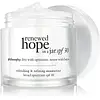What's inside
What's inside
 Key Ingredients
Key Ingredients

 Benefits
Benefits

 Concerns
Concerns

No concerns
 Ingredients Side-by-side
Ingredients Side-by-side

Water
Skin ConditioningHydrogenated Polyisobutene
EmollientGlycerin
Humectant1,2-Hexanediol
Skin ConditioningHydroxyethyl Acrylate/Sodium Acryloyldimethyl Taurate Copolymer
Emulsion StabilisingGlyceryl Stearate
EmollientPEG-100 Stearate
Squalane
EmollientPalmaria Palmata Extract
Skin ProtectingHydrolyzed Hyaluronic Acid
HumectantSodium Hyaluronate
HumectantTocopheryl Acetate
AntioxidantPhenoxyethanol
PreservativePolysorbate 60
EmulsifyingSorbitan Isostearate
EmulsifyingCetyl Alcohol
EmollientTrisodium Ethylenediamine Disuccinate
Water, Hydrogenated Polyisobutene, Glycerin, 1,2-Hexanediol, Hydroxyethyl Acrylate/Sodium Acryloyldimethyl Taurate Copolymer, Glyceryl Stearate, PEG-100 Stearate, Squalane, Palmaria Palmata Extract, Hydrolyzed Hyaluronic Acid, Sodium Hyaluronate, Tocopheryl Acetate, Phenoxyethanol, Polysorbate 60, Sorbitan Isostearate, Cetyl Alcohol, Trisodium Ethylenediamine Disuccinate
Butyl Methoxydibenzoylmethane 2.7%
UV AbsorberEthylhexyl Methoxycinnamate 6.99%
UV AbsorberOctocrylene 2%
UV AbsorberWater
Skin ConditioningCarthamus Tinctorius Oleosomes
EmollientButylene Glycol
HumectantGlycerin
HumectantC12-15 Alkyl Benzoate
AntimicrobialMethyl Gluceth-20
HumectantGlycolic Acid
BufferingPolyacrylamide
Cyclopentasiloxane
EmollientAmmonium Acryloyldimethyltaurate/Vp Copolymer
Hydrogenated Lecithin
EmulsifyingCyclohexasiloxane
EmollientPhenoxyethanol
PreservativeSodium Hydroxide
BufferingC13-14 Isoparaffin
EmollientCetyl Alcohol
EmollientPolysorbate 80
EmulsifyingLaureth-7
EmulsifyingCitric Acid
BufferingParfum
MaskingCI 77163
Cosmetic ColorantMandelic Acid
AntimicrobialTocopheryl Acetate
AntioxidantDisodium EDTA
Synthetic Fluorphlogopite
Ethylhexyl Palmitate
EmollientPropanediol
SolventGluconic Acid
Adenosine
Skin ConditioningSodium Benzoate
MaskingBHT
AntioxidantEvodia Rutaecarpa Fruit Extract
Skin ConditioningSodium Bicarbonate
AbrasiveYeast Extract
Skin ConditioningMagnesium Stearate
Cosmetic ColorantOpuntia Coccinellifera Flower Extract
Skin ConditioningSilica Dimethyl Silylate
EmollientCaprylyl Glycol
EmollientEthylhexylglycerin
Skin ConditioningHyaluronic Acid
HumectantSilanetriol
Sodium Hyaluronate
HumectantSorbic Acid
PreservativeHexylene Glycol
EmulsifyingButyl Methoxydibenzoylmethane 2.7%, Ethylhexyl Methoxycinnamate 6.99%, Octocrylene 2%, Water, Carthamus Tinctorius Oleosomes, Butylene Glycol, Glycerin, C12-15 Alkyl Benzoate, Methyl Gluceth-20, Glycolic Acid, Polyacrylamide, Cyclopentasiloxane, Ammonium Acryloyldimethyltaurate/Vp Copolymer, Hydrogenated Lecithin, Cyclohexasiloxane, Phenoxyethanol, Sodium Hydroxide, C13-14 Isoparaffin, Cetyl Alcohol, Polysorbate 80, Laureth-7, Citric Acid, Parfum, CI 77163, Mandelic Acid, Tocopheryl Acetate, Disodium EDTA, Synthetic Fluorphlogopite, Ethylhexyl Palmitate, Propanediol, Gluconic Acid, Adenosine, Sodium Benzoate, BHT, Evodia Rutaecarpa Fruit Extract, Sodium Bicarbonate, Yeast Extract, Magnesium Stearate, Opuntia Coccinellifera Flower Extract, Silica Dimethyl Silylate, Caprylyl Glycol, Ethylhexylglycerin, Hyaluronic Acid, Silanetriol, Sodium Hyaluronate, Sorbic Acid, Hexylene Glycol
 Reviews
Reviews

Ingredients Explained
These ingredients are found in both products.
Ingredients higher up in an ingredient list are typically present in a larger amount.
Cetyl Alcohol is a fatty alcohol. Fatty Alcohols are most often used as an emollient or to thicken a product.
Its main roles are:
Though it has "alcohol" in the name, it is not related to denatured alcohol or ethyl alcohol.
The FDA allows products labeled "alcohol-free" to have fatty alcohols.
Learn more about Cetyl AlcoholGlycerin is already naturally found in your skin. It helps moisturize and protect your skin.
A study from 2016 found glycerin to be more effective as a humectant than AHAs and hyaluronic acid.
As a humectant, it helps the skin stay hydrated by pulling moisture to your skin. The low molecular weight of glycerin allows it to pull moisture into the deeper layers of your skin.
Hydrated skin improves your skin barrier; Your skin barrier helps protect against irritants and bacteria.
Glycerin has also been found to have antimicrobial and antiviral properties. Due to these properties, glycerin is often used in wound and burn treatments.
In cosmetics, glycerin is usually derived from plants such as soybean or palm. However, it can also be sourced from animals, such as tallow or animal fat.
This ingredient is organic, colorless, odorless, and non-toxic.
Glycerin is the name for this ingredient in American English. British English uses Glycerol/Glycerine.
Learn more about GlycerinPhenoxyethanol is a preservative that has germicide, antimicrobial, and aromatic properties. Studies show that phenoxyethanol can prevent microbial growth. By itself, it has a scent that is similar to that of a rose.
It's often used in formulations along with Caprylyl Glycol to preserve the shelf life of products.
Sodium Hyaluronate is hyaluronic acid's salt form. It is commonly derived from the sodium salt of hyaluronic acid.
Like hyaluronic acid, it is great at holding water and acts as a humectant. This makes it a great skin hydrating ingredient.
Sodium Hyaluronate is naturally occurring in our bodies and is mostly found in eye fluid and joints.
These are some other common types of Hyaluronic Acid:
Learn more about Sodium HyaluronateTocopheryl Acetate is AKA Vitamin E. It is an antioxidant and protects your skin from free radicals. Free radicals damage the skin by breaking down collagen.
One study found using Tocopheryl Acetate with Vitamin C decreased the number of sunburned cells.
Tocopheryl Acetate is commonly found in both skincare and dietary supplements.
Learn more about Tocopheryl AcetateWater. It's the most common cosmetic ingredient of all. You'll usually see it at the top of ingredient lists, meaning that it makes up the largest part of the product.
So why is it so popular? Water most often acts as a solvent - this means that it helps dissolve other ingredients into the formulation.
You'll also recognize water as that liquid we all need to stay alive. If you see this, drink a glass of water. Stay hydrated!
Learn more about Water